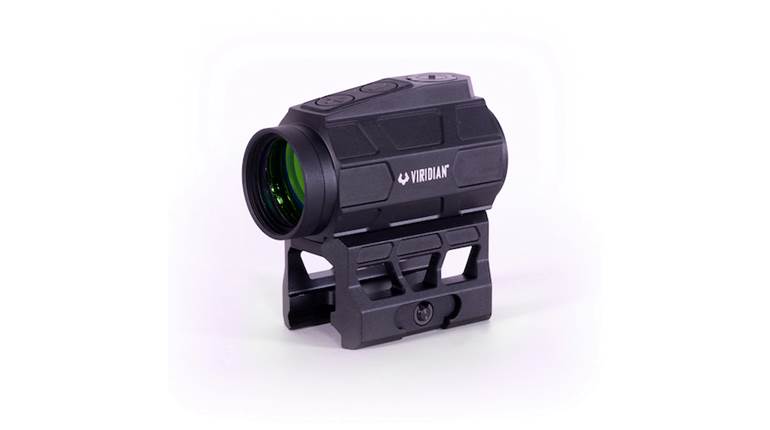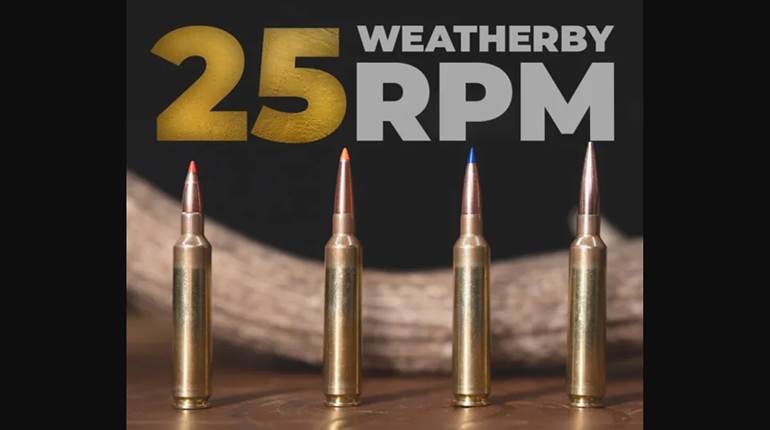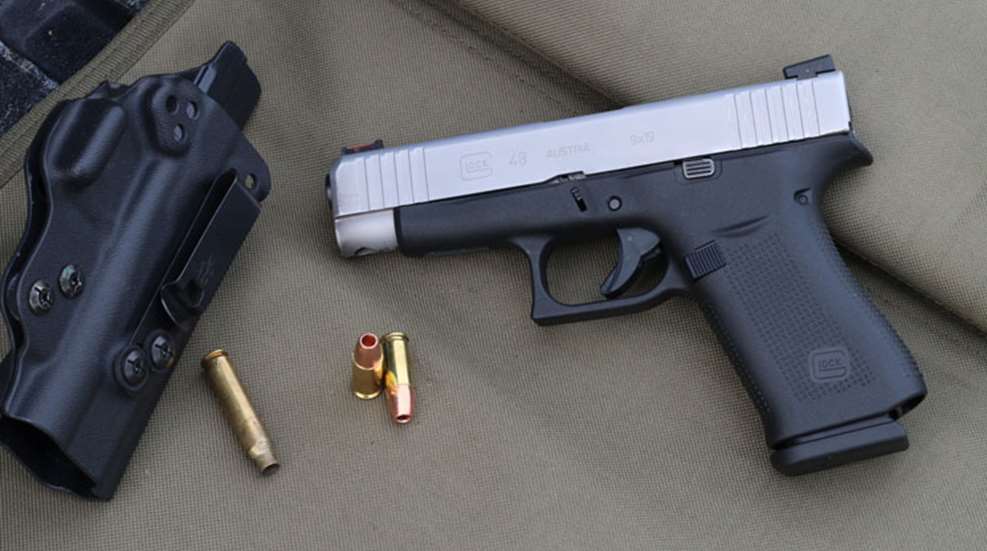
Announced at the 2019 SHOT Show, the new Glock 48 pistol is already on dealers' shelves. The 48 is, more or less, the “full size’” version of Glock’s popular 43 single-stack subcompact, with a longer grip, a 10-round magazine and a 4.1” barrel. Another way to look at it is that the 48 is a single-stack, thin version of the popular double-stack Model 19, being similar in most dimensions other than thickness (1.10” vs 1.26”).
The slimline 48 has generated a great deal of interest and discussion between one camp that sees the answer to its Glockish prayers and another that doesn’t get the point. I was able to get my hands on one through normal dealer channels and can offer some early shooting results. The bottom line assessment is that the 48 shoots big and carries small, an achievement in a world of compromises that allows one to have most of the cake while eating a good chunk of it also.
Shootability: Accuracy
Getting a feel for the slimline 9 mm in dry fire I had a sense that the pistol might shoot pretty well. The trigger broke nicely and cleaner than any factory Glock I’ve handled. The total weight was 5.25 lbs. and a consistent 3.5 lbs. with the slack taken out. Glock has made some real strides here— this trigger was nicer than my Gen 4 model 34 after polishing and tweaking. At the range and following a few magazines to get acquainted with how the striker released and sights lifted in recoil I fired a few representative groups off of a standing rest.
Representative groups are just that: They are the sudden-death, single-elimination approach to seeing the pistol’s capabilities. I suspect the ghosts of both General Hatcher and Colonel Whelen may haunt me for only firing the representative group; the standard protocol of five groups for each load is more thorough and informative, but the single clusters give a directional sense of the little pistol’s capability. Defensive hollow points from Black Hills and Hornady shot into quite nice groups, while some of the range ammo provided enough precision for even the most challenging drills. The average across all six loads was a respectable 2.7”.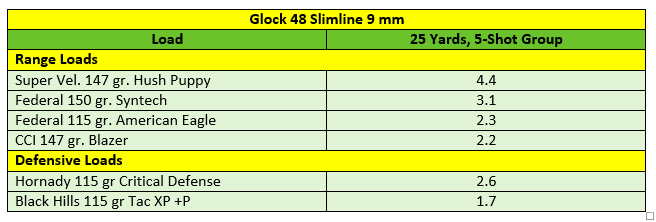
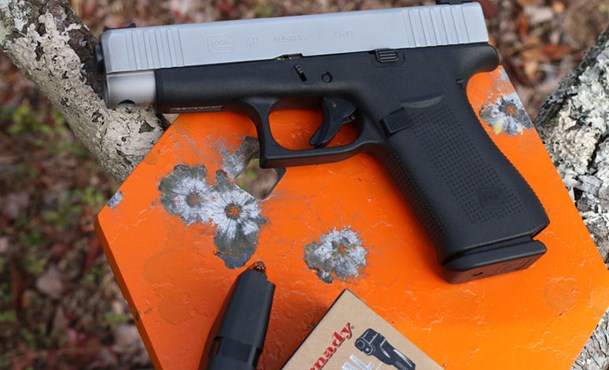
Even with my XL gloved hands I was able to get just enough of both the firing and support hand where they needed to be to steady the shot, albeit without any room to speak of left over. The new Glock had just enough mass to hold relative steady as I broke the shots and the hits came without the effort required for many subcompacts to connect. I was able to consistently go five for five on an 8” plate at 35 yards while keeping a practical tempo to break each shot in four to five seconds. Hitting the steel was possible out to 40, it just took more time and discipline to ring it compared to a full-sized pistol.
Stepping up to 20 yards from the MGM plate rack I ran through one of my standard drills, which is three plates from the ready in four seconds or less. The two-tone single stack had no trouble knocking threes with a little time to spare.
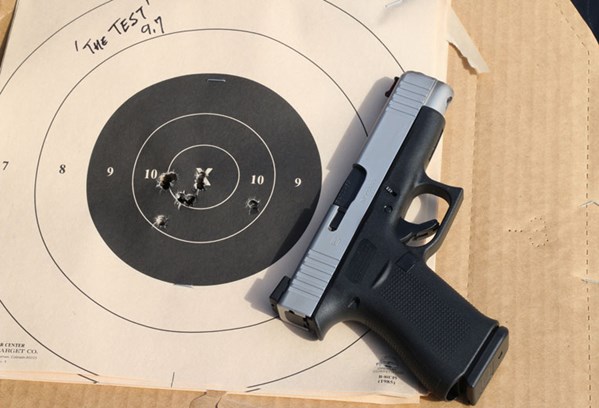
At 10 yards I fired legendary trainer Ken Hackathorn’s “Test”: 10 shots on a B8 bullseye in 10 seconds from the ready position. The 48 stacked all 10 of the red-coated Federal Syntechs into the 10-ring on the first attempt. That is about as good as I’m good for with any of my favored pistols and would be an outlier with a subcompact.
Shootability: Speed
The 48’s slightly longer frame allows a full firing grip. All three fingers had room on the frontstrap and the heel of my hand had a firm anchor on the backstrap. This last point is part of the advantage relative to the subcompact genre, where even if the little finger is wrapped around a magazine extension the backstrap may not extend deep enough into the hand for the bottom of the palm to gain leverage.
There is definitely more movement in recoil than one would feel in a larger Glock, but decidedly less muzzle rise than shooting a subcompact. The recoil impulse is not unpleasant. With a good grasp on the handgun there was a slight bit of shifting as the pistol wanted to twist compared to the stability in recoil I experience with a double stack compact—I suspect that this is the thinness at play, the 48 simply having less surface area on the frontstrap for the fingers to anchor against. However, the front sight was still tracking within the rear sight notch and returning easily.
This showed in my 10-yard plate rack times, which were about two tenths of a second behind my times with a full-size Glock 17 tweaked as I like (and right there in the same bracket with many stock compacts). The times to hit six plates were consistent run to run, which is a very positive sign for the little Glock.
I pushed the 48 across a number of practical drills and in most cases my times or scores were about 10 percent behind well set up full sized pistols and a good 30 percent ahead of the subcompact class.
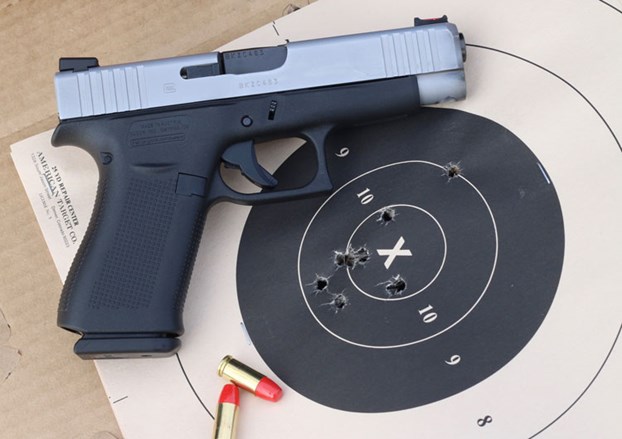
My five-yard roundup drill is a benchmark I use frequently. The drill has strings from the holster, ready, and strong hand only as well as support hand only; each at five yards with a time limit of 2.5 seconds. Ten total shots equal a possible 100 and the slimline posted 98s on the first two runs and a possible one run later; again significantly ahead of any early attempts with a subcompact and on par with better full-size pistols.
Controls
There is no free lunch and the smallness of the 48 struck me in controls. The controls were operable but I found getting to the slide or magazine releases more awkward than with a midsize like a Glock 19. The “tween-ness” of the 48 slewed more to the subcompact side in reloads, with times to perform a slide-lock reload a bit behind my averages with compacts. Still, reloads were certain and more consistent than with the pocket sized single stacks. I also suspect that the median hand size will find this to be less of an issue, while those with small hands may actually handle the 48 like a champ.
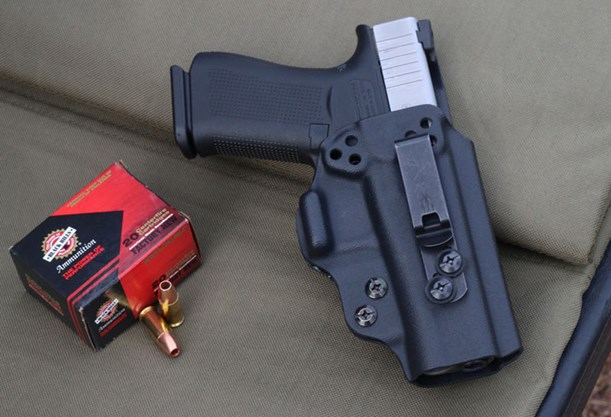
Draw
I carried the 48 in a Tenicor Velo model holster, which is meant to be used inside the waistband at the “appendix” position. The holster was comfortable and did an excellent job of making the thin 9 mm disappear. The extra length of the frame allowed me to acquire a very positive grasp on the pistol to begin the drawstroke and my times at seven yards were essentially no different than what I average with midsized pistols. The first 10 attempts with the 48/Velo ranged from 1.01 to 1.22 second and averaged 1.07. I’ve struggled to get that kind of speed out of the six and seven shot subcompacts, where I am usually consistent with positive control near 1.45 and down to 1.25 when things come together. This extra control, speed, and consistency from the holster is a significant upside and is probably attributable to having just enough extra grip to target and latch onto with the draw.
Counterpoints
There are a few points worth noting from my early range trips. First, the sights. I didn’t even bother with the Glock polymer sights, having my FFL install a set of Dawson Glock 19 sights before I even took possession. That Glock still cuts costs by installing such cheesy sights onto their base pistols is something that strikes me as either annoying or outrageous depending on how charitable I am feeling. I would not expect the same level of success in shooting the little 48 with the sub-optimal OEM polys.
Second, the pistol has as low a bore axis that can be achieved, a general good. However, this led the slide to rub my quite high, thumbs-forward grip. For me it is noticeable, but not necessarily painful within normal shooting. The rub became a hotspot at about 175 rounds, with the skin just nicked and was a distraction by the time I had 400 empty casings piled up. I suspect that those with meaty hands will notice this sooner and those with smaller hands or a lower grip may not notice at all.
The final quibble is that the pistol does not easily eject live rounds, particularly the longer projectiles common to hollow points and heavier FMJ. If the slide is worked vigorously all is well, but in the normal administrative handling the rounds require considerable finagling to clear.
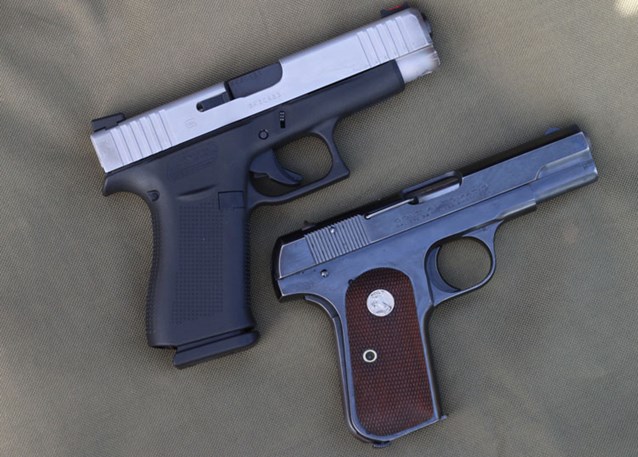
The Glock 48 has a lot of potential. It is remarkably close in overall dimensions to the classic Colt 1903 Pocket Hammerless, an iconic and well regarded concealed carry semi-automatic from long ago. The Glock is actually lighter by an ounce than the Colt fully loaded and only .05" thicker through the slide, while being thinner through the grip. The Colt was wildly popular and was as likely to be found in a sock drawer as a home-defense piece as it was likely to be discreetly carried on the person. I suspect that both market constituencies will latch onto the Glock 48 for many of the same reasons, with the upside of 11 rounds of 9 mm housed in a concealable, shootable package.












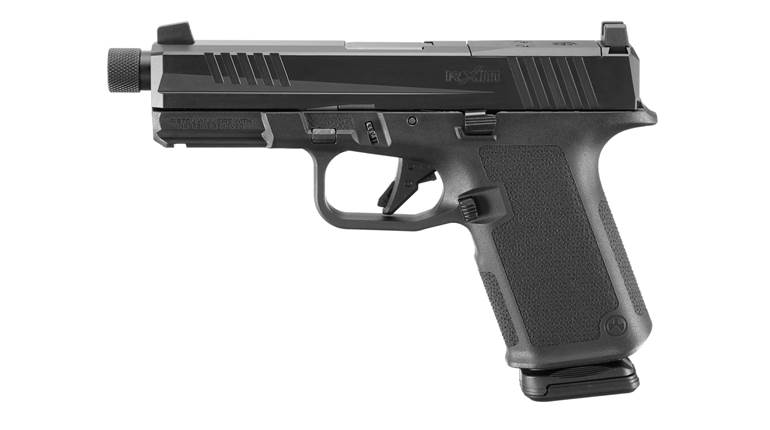
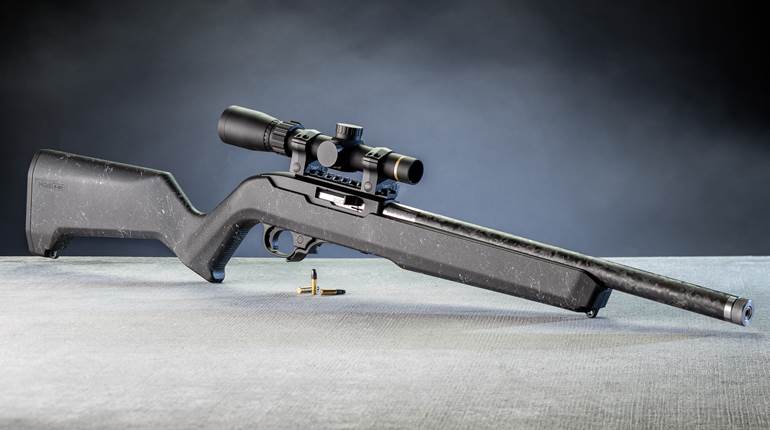

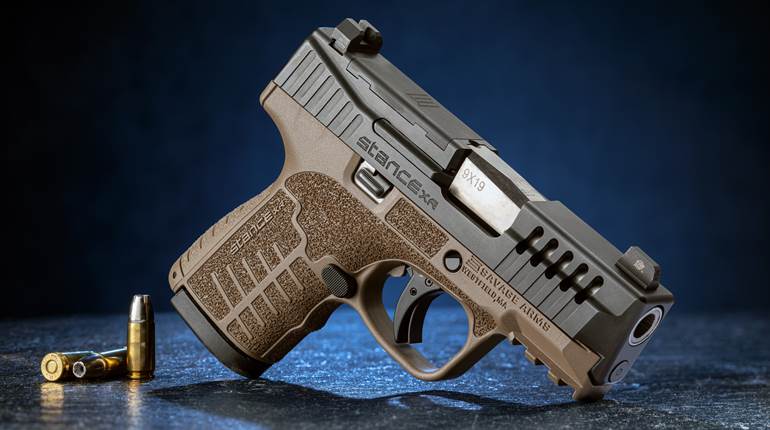
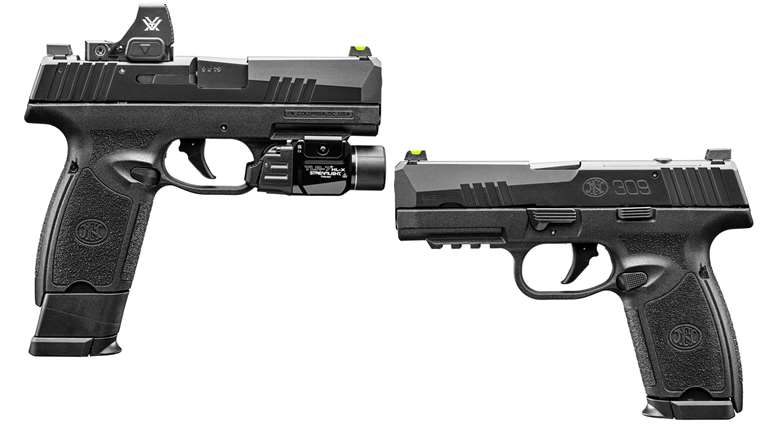

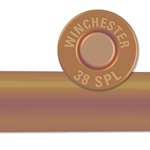
![Oconnor Small[67]](/media/bu2le2tp/oconnor-small-67.jpg?anchor=center&mode=crop&width=770&height=430&rnd=134126774953630000&quality=60)
![Oconnor Small[67]](/media/bu2le2tp/oconnor-small-67.jpg?anchor=center&mode=crop&width=150&height=150&rnd=134126774953630000&quality=60)









